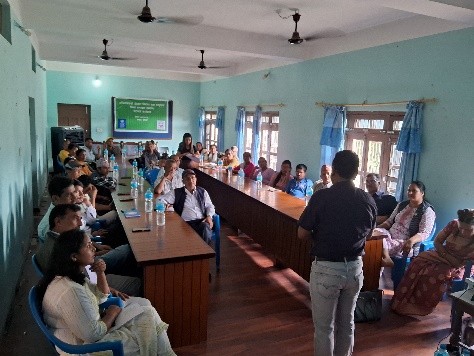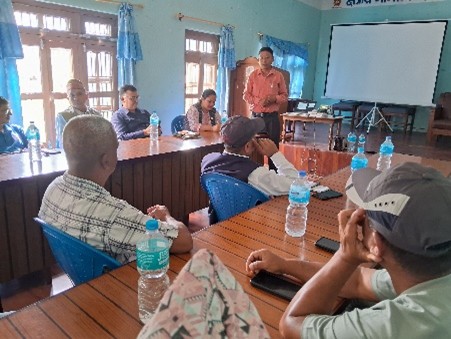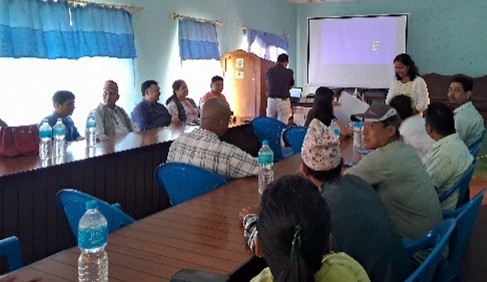The program was formally inaugurated by Ms. Aarti Pathak, who welcomed the participants and outlined the objectives of the event. Mr. Ghanshyam Pandey then shared introductory remarks, emphasizing the importance of collective efforts in addressing the challenges faced by community forests. He also explained the overall process of the events that were taken place in the previous days for the preparation of RBA plan, SOP for rescue team and guidelines for rapid response during crisis. All the events that were being taken place were in chronological order for the finalization of RBA plan, SOP and the guideline. So, he requested all the participants to provide the consultants present for the active participation. Following this, the floor was handed over to Mr. Dipendra Kumar Pathak to lead the discussions.
Mr. Dipendra Kumar Pathak provided an overview of past natural disasters and calamities in Nepal, distinguishing between various types of disasters and discussing specific events affecting community forests in recent years. The highlighted disasters included:
- Wildfires
- Landslides
- Soil erosion
- Lightning strikes
- Earthquakes
- Prolonged heavy rainfall
Participants also identified several non-natural challenges such as illegal poaching, encroachment of forest areas, plant diseases, illicit harvesting of medicinal herbs, human-wildlife conflict, and unplanned development near forest areas. The CFUG members also raised a question about future challenges that may occur in their respective CFUG such as dying back of Sal and diseases in the timber since most of the forest are covered with Sal. This raised a question and risk factor for the future challenge as well.
Following his presentation, group work was assigned to all participating Community Forest User Groups (CFUGs) to encourage collaborative discussions and solutions. The group work questions were as follows:
- What are the major disaster events faced by Community Forest User Groups?
- What efforts have been made to address disasters?
- What should the groups do in the coming days for disaster management?
- What policies, tools, and resources are required for disaster management?
- What kind of structure should the groups build for disaster management?
- What activities should the groups undertake before, during, and after disasters?
- What preparations are necessary to manage disasters effectively?
The results of the group discussions highlighted the critical need for targeted plans and proactive measures. This naturally transitioned into the next session, which focused on addressing challenges specific to community forests and identifying actionable solutions.
Following Mr. Pathak’s session, Forest Officer Mr. Basanta Raj Gautam facilitated a discussion on the challenges faced by community forests. He highlighted advocacy opportunities at the local level and encouraged participants to create plans focused on community rights. He expressed gratitude to Mr. Ghanshyam Pandey for providing a platform for these discussions and requested ongoing support for future initiatives.
Mr. Ghanshyam Pandey announced a two-day training program on Rights-Based Advocacy Plan Development, to be held in each community forest. This training will delve into previously raised issues, transforming them into actionable advocacy plans. Participants will have the opportunity to discuss these challenges in detail during the sessions. Building on these discussions, the program moved to address the critical need for preparedness and response strategies for crises. This transition was aimed at equipping participants with a comprehensive understanding of disaster management to complement the challenges they had identified.
Mr. Pathak emphasized the importance of formulating robust disaster management plans, focusing on pre-disaster preparedness, disaster response, and post-disaster recovery. He explained the need for risk assessments, capacity building, resource allocation, and stakeholder coordination. Additionally, he stressed that effective implementation requires task allocation and identification of alternative measures. The program concluded with an overview of the proposed two-day training on good governance, inclusivity, leadership development, and the role of community forests.
This consultation marked a significant step toward empowering community forests and stakeholders to address crises effectively. The planned training and discussions were expected to strengthen disaster preparedness and enhance the resilience of community forests and their users. The consultation meeting was fruitful for the preparation of RBA Plan, SOP and Guideline for the rapid response during crisis.
The program was formally closed by Ms. Bharati Pathak, who thanked all participants for their active involvement and commitment to strengthening community forest management.












